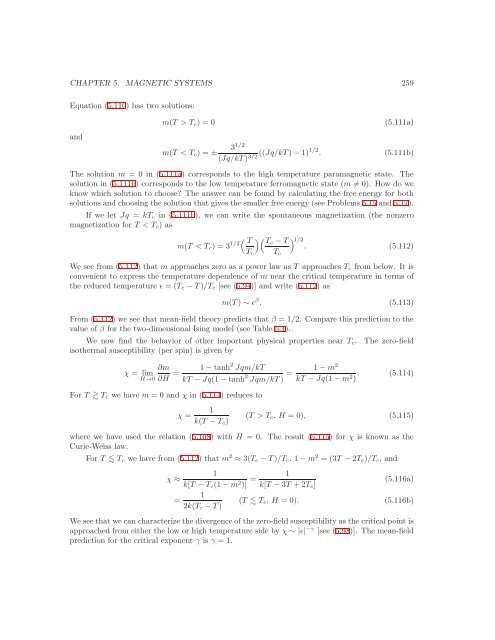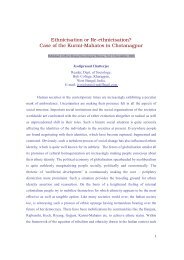Chapter 5 - WebRing
Chapter 5 - WebRing
Chapter 5 - WebRing
You also want an ePaper? Increase the reach of your titles
YUMPU automatically turns print PDFs into web optimized ePapers that Google loves.
CHAPTER 5. MAGNETIC SYSTEMS 259<br />
Equation (5.110) has two solutions:<br />
and<br />
m(T > Tc) = 0 (5.111a)<br />
3<br />
m(T < Tc) = ±<br />
1/2<br />
(Jq/kT) 3/2((Jq/kT)−1)1/2 . (5.111b)<br />
The solution m = 0 in (5.111a) corresponds to the high temperature paramagnetic state. The<br />
solution in (5.111b) corresponds to the low temperature ferromagnetic state (m = 0). How do we<br />
know which solution to choose? The answer can be found by calculating the free energy for both<br />
solutions and choosing the solution that gives the smaller free energy (see Problems 5.15 and 5.17).<br />
If we let Jq = kTc in (5.111b), we can write the spontaneous magnetization (the nonzero<br />
magnetization for T < Tc) as<br />
m(T < Tc) = 3 1/2 T<br />
<br />
Tc −T<br />
Tc<br />
Tc<br />
1/2<br />
. (5.112)<br />
We see from (5.112) that m approaches zero as a power law as T approaches Tc from below. It is<br />
convenient to express the temperature dependence of m near the critical temperature in terms of<br />
the reduced temperature ǫ = (Tc −T)/Tc [see (5.94)] and write (5.112) as<br />
m(T) ∼ ǫ β . (5.113)<br />
From (5.112) we see that mean-field theory predicts that β = 1/2. Compare this prediction to the<br />
value of β for the two-dimensional Ising model (see Table 5.1).<br />
We now find the behavior of other important physical properties near Tc. The zero-field<br />
isothermal susceptibility (per spin) is given by<br />
∂m<br />
χ = lim<br />
H→0 ∂H =<br />
1−tanh 2 Jqm/kT<br />
kT −Jq(1−tanh 2 Jqm/kT) =<br />
For T Tc we have m = 0 and χ in (5.114) reduces to<br />
χ =<br />
1<br />
k(T −Tc)<br />
1−m 2<br />
kT −Jq(1−m 2 . (5.114)<br />
)<br />
(T > Tc, H = 0), (5.115)<br />
where we have used the relation (5.108) with H = 0. The result (5.115) for χ is known as the<br />
Curie-Weiss law.<br />
For T Tc we have from (5.112) that m 2 ≈ 3(Tc −T)/Tc, 1−m 2 = (3T −2Tc)/Tc, and<br />
1<br />
χ ≈<br />
k[T −Tc(1−m 2 )] =<br />
1<br />
k[T −3T +2Tc]<br />
(5.116a)<br />
1<br />
=<br />
2k(Tc −T)<br />
(T Tc, H = 0). (5.116b)<br />
We see that we can characterizethe divergenceof the zero-field susceptibility as the critical point is<br />
approached from either the low or high temperature side by χ ∼ |ǫ| −γ [see (5.98)]. The mean-field<br />
prediction for the critical exponent γ is γ = 1.

















